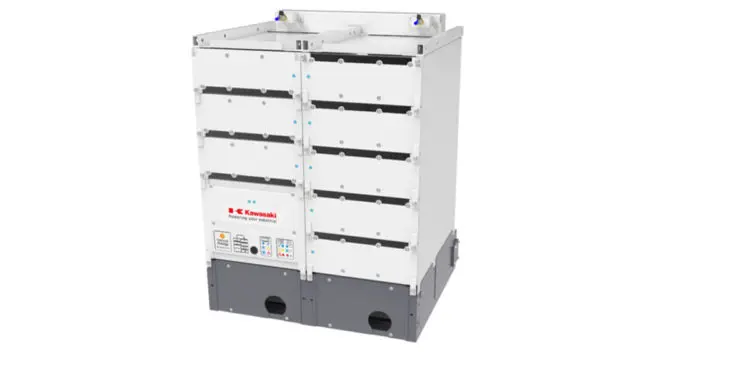Bergen, Norway and Vancouver, Canada – June 2, 2020 — Corvus Energy is pleased to announce that Kawasaki Heavy Industries (KHI) of Tokyo, Japan has ordered the first commercial unit of a new Corvus Energy high-density lithium-ion capacitor energy storage system (ESS).
Branded Blue Marlin, the product uses lithium-ion capacitor (LiC) cells that safely sustain very high charge/discharge rates of 550 C peak and 200 C continuous, enabling both energy recapture and fast discharge for high-power load handling. It can deliver beyond a million cycles with minimal capacity loss.
Corvus Energy incorporated the LiC technology into the maritime-specific Blue Marlin product under a product development agreement with KHI, first announced in September 2019.
“Corvus Energy has been an outstanding development partner. They have demonstrated high standards in energy storage engineering and marine market expertise throughout this project. Their know-how around thermal management inside battery modules is unmatched and critical to ensuring safe and reliable operation,” says Takeshi Ohata, Managing Executive Officer of Kawasaki Heavy Industries.
“This project demonstrates that LiC technology is well-suited to maritime and offshore energy recapture applications,” says Sean Puchalski, EVP Strategy & Business Planning at Corvus Energy. “It provides the best of both worlds—current-handling performance nearing a supercapacitor with improved energy density. When space is at a premium and high power is required for short amounts of time, the Corvus Energy Blue Marlin product is a fantastic solution.”
Corvus Energy will market the Blue Marlin ESS mainly in the Offshore segment for applications with short power fluctuations at a very high power. With its lightweight, ruggedized and high power-density design, Blue Marlin provides significant benefits in such applications. For example, the potential for efficiency improvement through energy recapture is substantial for many of these operations, including heave compensation, drilling draw works, payload lowering, and similar high-power applications. Further, it can handle peaks in the power demand profile. For drilling rigs and vessels with heave compensation systems, this could mean that one or more diesel generators previously used to handle sudden variations in power can be turned off.
“The entire oil and gas industry increasingly commit to invest in green technology to reduce the carbon footprint of their operations,” says Geir Bjørkeli, CEO of Corvus Energy. “We are pleased that by adding the Blue Marlin, we now offer a complete portfolio to improve energy efficiency in offshore vessel operations as well as rig topside applications.”
As the leading manufacturer of energy storage systems (ESS) for maritime applications, Corvus Energy provides battery power to more hybrid or zero-emission vessels than all other providers of energy storage systems combined. Corvus Energy offers a comprehensive and innovative portfolio of ESS solutions and has unsurpassed experience from 300+ projects, totaling over 250 MWh and 2,5 million operating hours.






























